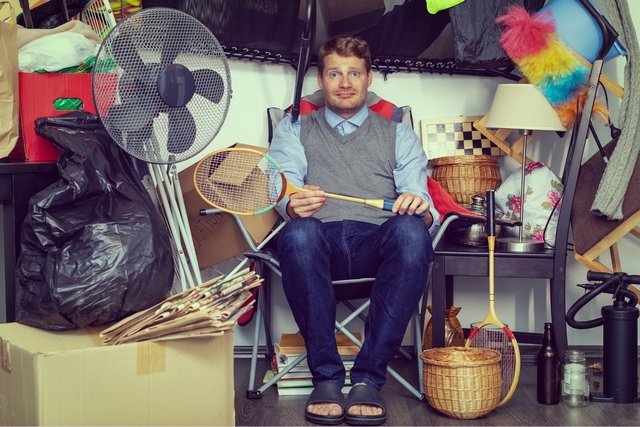Compulsive hoarders are people who collect and keep various objects, regardless of their real value, having great difficulty discarding or separating themselves from their belongings. Therefore, it is common for these people’s homes and workplaces to have many objects accumulated, interfering with circulation and the use of surfaces.
People with hoarding disorder may be aware of their problem, however, there are hoarders who may present delusional ideas and should be diagnosed and treated by a psychologist or psychiatrist.
The accumulation of objects can result in the deterioration of social and work relationships and, therefore, it is important that these people receive and accept support from their family and friends, as the person themselves often do not see it as a problem and Therefore, he does not seek treatment, which must be done under the guidance of a psychologist.

Main symptoms
The main symptoms of compulsive hoarders are:
- Difficulty getting rid of objects, regardless of their real value;
- Difficulty organizing your belongings and losing important objects, such as money and keys, for example;
- Accumulating objects in all places at home, at work, in the car and in some storage areas;
- Being excessively afraid of being left without an object;
- Feeling that they cannot throw an object in the trash, as they may need it in the future;
- Search for new objects, even when you already have several of the same one;
- Buying things just because they are cheap.
Furthermore, people who are compulsive hoarders also become more isolated, especially in more severe cases, as they are ashamed of their own situation and the appearance of their home. For this reason, these people are more likely to develop other psychiatric illnesses, such as depression, for example.
What is the difference between an accumulator and a collector?
The hoarder can often be confused with a collector, or can even use the excuse of collecting, just so that others don’t see him in a strange way.
However, an easy way to distinguish both situations is that, normally, the collector takes pride in showing and organizing his collection, while the hoarder can acquire objects that have no relation to each other and prefers to keep them secret, in addition to hiding them. objects that accumulate, resulting in greater difficulty in organizing.
Possible causes
The exact cause that leads a person to accumulate excessive objects is not known, however, it is possible that it is related to genetic factors, brain functioning or stressful events in the person’s life.
How the treatment is carried out
Treatment for compulsive hoarders can be done through behavioral therapy, with the psychologist trying to discover the cause of the anxiety that is causing the desire to keep things. However, this treatment can take several years to take effect as it requires a lot of dedication from the person.
Antidepressant medications can also be used to complement treatment, helping the patient to avoid the desire for compulsive accumulation, but, in this case, they must be recommended by a psychiatrist.
Typically, compulsive hoarders do not seek treatment because they do not realize that their situation is an illness, so family and friends play a very important role in helping the person heal.
Possible complications
Although hoarding may seem like a little worrying disorder, the truth is that it can have several health risks, especially related to allergies and frequent infections, as excess objects make the task of cleaning the house more difficult, facilitating the accumulation of waste. bacteria, fungi and viruses.
Furthermore, depending on the degree of accumulation of objects, there may also be a risk of accidental falls or even burial, as objects may fall on top of the person.
On a psychological level, compulsive hoarders are also more likely to become isolated and can develop serious depression, especially when they recognize the problem but do not wish, or cannot, undergo treatment.
Bibliography
- American Psychiatric Association. Diagnostic and Statistical Manual of Mental Disorders DSM-5. 5th ed. United States: 2014. 247-251.
- MAYO CLINIC. Hoarding disorder. Disponível em: <https://www.mayoclinic.org/diseases-conditions/hoarding-disorder/symptoms-causes/syc-20356056>. Acesso em 30 abr 2019
- NHS. Hoarding disorder. Available at: <https://www.nhs.uk/conditions/hoarding-disorder/>. Accessed on April 30, 2019
- ADKISSON, Carol. The Mind of a Hoarder. Journal of Psychology and Brain Studies. Vol.2. 1-4, 2018
- INTERNATIONAL OCD FOUNDATION. What is compulsive hoarding?. Disponível em: <http://www.hoardingtaskforcesaginaw.org/documents/Hoarding_Fact_Sheet.9891600.pdf>. Acesso em 11 jan 2024

Sign up for our newsletter and stay up to date with exclusive news
that can transform your routine!
Warning: Undefined array key "title" in /home/storelat/public_html/wp-content/plugins/link-whisper-premium/templates/frontend/related-posts.php on line 12
Warning: Undefined array key "title_tag" in /home/storelat/public_html/wp-content/plugins/link-whisper-premium/templates/frontend/related-posts.php on line 13



